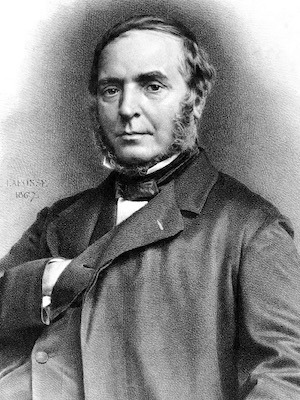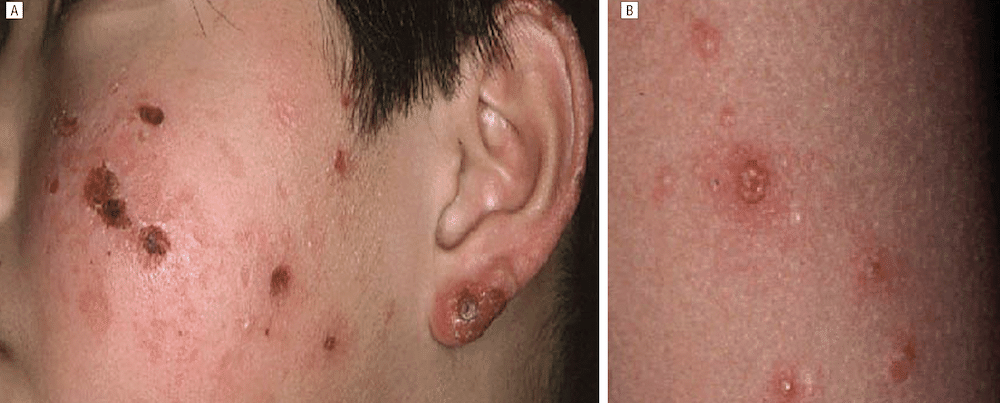Ernest Bazin

Pierre-Antoine-Ernest Bazin (1807-1878) was a French physician and dermatologist.
Bazin made important contributions to the study of syphilis and scrofula. He was a pioneer in applied mycology, recognizing ringworm and favus to be due to vegetable parasites and was one of the first to popularize the acarus as the causative agent of scabies.
Bazin is remembered for describing in detail Scrofulides érythémateuses (Bazin disease); enhancing the description by Alibert of mycosis fungoides; and first describing hydroa vacciniforme
He founded 2 medical journals: in 1839 “L’Institut médical, journal scientifique et littéraire” which, for financial reasons, ceased to appear on November 20, 1839 and in 1848, the “Répertoire des Etudes Médicales” which had only 7 issues.
Biography
- Born on February 20, 1807 in Saint-Brice-sous-Forêt, France
- 1828 – First in the competition for the Externat des Hôpitaux de Paris, Bazin was appointed to the Internat des Hôpitaux de Paris
- 1834 – Thesis: Researches on the Pulmonary Lesions to be Considered in the Morbid Affections Known as the Essential Fevers.
- 1836 – Médecin des hôpitaux
- 1841 – Hôpital Lourcine
- 1844 – Hôpital Saint-Antoine
- 1847 – Hôpital Saint-Louis
- Died on December 14, 1878
The true nosologist does not set forth from physiology, or anatomy, or pathological anatomy in order to study diseases and to classify them by a simple and natural method, he starts out with the patient and observation is his torch. Bazin arrived too soon in a medical world which was too much occupied with the sole anatomical lesion. That was his misfortune.
Louis-Anne-Jean Brocq (1856-1928)
Medical Eponyms
Bazin disease [*Scrofulides érythémateuses, erythema induratum, erythème induré]
Erythema induratum is a panniculitis on the calves, occurring mainly in women. Historically, it has been most commonly described in association with cutaneous tuberculosis. The medical eponym Bazin disease applies only to the tuberculous form and is archaic
L’érythème induré, de nature scrofuleuse, n’est pas rare; il se caractérise par des plaques rouges, indurées, sur lesquelles le doigt appliqué fait momentanément disparaître la rougeur, qui ne tarde pas cà reparaître au houL de quelques instants. On sent à la peau et sous la peau une induration qui s’enfonce plus ou moins profondément dans le tissu cellulaire sous-cutané. La rougeur, plus ou moins foncée, assez souvent violacée, plus marquée au centre, se fond insensiblement sur la circonférence avec la couleur normale de la peau. Il n’y a sur ces plaques aucun prurit; la pression avec le doigt y est à peine douloureuse.
Cette affection s’observe communément sur les jambes, plus souvent peut-être chez les filles que cbez les garçons. Je l’ai souvent rencontrée sur les jambes des jeunes blanchisseuses, chez des jeunes filles offrant tous les attributs de la fraîcheur et de l’embonpoint scrofuleux. Son siège de prédilection est la partie externe et inférieure de la jambe. On la voit quelquefois aussi siéger un peu au-dessus du talon, le long du tendon d’Achille. Enfin, on peut la remarquer encore sur la face, et je l’ai vue, sur cette région, alterner avec l’ophthalmie scrofuleuse.
Erythema induratum, of a scrofulous nature, is not rare; it is characterized by red indurated plaques from which, with digital pressure, the redness disappears momentarily, soon to return. One feels an induration on the skin and in the skin which reaches more or less deeply into the subcutaneous cellular tissue. The redness which is more or less dark, quite often violaceous, and more marked in the center, blends insensibly at the periphery with the normal colour of the skin. There is no itching in these plaques; digital pressure on them causes scarcely any pain.
This affection is observed commonly on the legs, more often perhaps in females than in males. I have often found it on the legs of young laundresses, young women with all the attributes of scrofulous corpulence and ruddiness. Its site of predilection is the lateral and lower part of the leg. At times one sees it located a little above the heel, along the Achilles tendon

Alibert-Bazin syndrome (1825, 1858)
Alibert-Bazin syndrome or mycosis fungoides is the most common form of cutaneous peripheral T-cell lymphoma frequently also affecting the lymph nodes and viscera. Three stages exist; premycoid; infiltrative and tumour stages. Typical symptoms and signs include eczematoid eruption, psoriasis, dermatitis exfoliativa, and parapsoriasis; later circinate and gyrate elevated plaques of various sizes persist.
1806 – Alibert described mycosis fungoides naming the lesion initially pian fungoides because
of its similarity to yaws. Observing later the cutaneous tumors, Alibert reported its mushroom-like
appearance and used the term mycosis fungoides, realizing also that it was not caused by a fungus
1862 – Ernest Bazin (1807-1878) described the natural evolution of the disease and defined its stages integrated into the staging: patch, plaque and tumour.

1938 – Dermatologist Albert Sézary (1880-1956) and cardiologist Yves Bouvrain (1910-2002) reported the triad of erythroderma (l’homme rouge), enlarged peripheral lymph nodes and circulating mononuclear cells with convoluted nuclei, named Sézary syndrome
1975 – The term cutaneous T-cell lymphoma was coined when the cell of origin of mycosis fungoides and Sézary syndrome was determined to be skin-homing T cells
Hydroa vacciniforme
Hydroa vacciniforme is a rare form of photosensitivity dermatoses which affects sun-exposed skin. The condition is characterised by recurrent fluid-filled blisters (hydroa) that heal with pox-like (vacciniform) scars.
l’Hydroa vacciniforme n’est pas connu des auteurs; l’année dernière, j’eus l’occasion d’ob- server cette singulière éruption. J’envoyai mon malade consulter plusieurs médecins des hôpitaux : les uns cru- rent qu’il s’agissait d’une affection syphilitique, d’autres ne se prononcèrent pas sur la nature de cette éruption…
Je ne crois pas que cette affection ait été décrite, cepen- dant il est important de la connaître à cause des graves erreurs qu’elle peut occasionner.
Symptômes: L’hydroa vacciniforme apparaît à la suite d’une promenade au grand air ou après l’exposition à un soleil ardent. Il existe un peu de malaise, de l’anorexie; l’éruption se montre d’abord sur les surfaces découvertes, puis sur les autres parties du corps. La muqueuse buccale est aussi envahie par l’affection.
On voit en premier lieu des taches rouges, sur lesquelles naissent bientôt des vésicules transparentes qui ressemblent à celles qu’on observe dans l’herpès. Dès le second jour, ces vésicules, qui sont arrondies, présentent une ombilication très évidente; en peu de temps, il se forme une croûte successivement au centre et à la circonférence de la vésicule. Lorsque celte croûte se détache, elle laisse une cicatrice déprimée.
Hydroa vacciniforme has not been described by other authors; last year I had the opportunity to observe this singular eruption. I sent my patient to several hospital physicians for consultation; some felt that it was a syphilitic affection; others would not commit themselves as to the nature of this eruption…
I do not believe that this affection has been described; it is, however, important to recognize it because of the grave errors it may otherwise occasion.
Symptoms. Hydroa vacciniforme appears following a walk in the open air, or after exposure to the hot sun. There is a little malaise and anorexia; the eruption appears first on the exposed surfaces, then on the other parts of the body. The buccal mucosa is also involved by the affection.
One sees, at first, red spots on which transparent vesicles which resemble those observed in herpes soon appear. On the second day these vesicles which are rounded show a very evident umbilication; in a short while a crust forms successively at the center, and at the circumference of the vesicle. When this crust comes off, it leaves a depressed cicatrix; in the case of the patient we spoke of above, the numerous cicatrices which covered the surface of the body would make one believe that he had formerly had variola.
The affection is prolonged for months by successive attacks

Major Publications
- Bazin E. Recherches sur la nature et le traitement des teignes. 1853
- Bazin E. Leçons théoriques et cliniques sur les affections cutanées parasitaires. 1858 [2e 1862]
- Bazin E. Leçons théoriques et cliniques sur la scrofule considérée en elle-même et dans ses rapports avec la syphilis, la dartre et l’arthritis. 1858 [Scrofulides érythémateuses 145-154, 501]
- Bazin E. Leçons théoriques et cliniques sur les syphilides. 1859
- Bazin E. Leçons théoriques et cliniques sur les affections cutanées de nature arthritique et dartreuse. 1860
- Bazin E. Leçons théoriques et cliniques sur les affections cutanées artificielles. 1862 [Alibert-Bazin syndrome 372-279]
- Bazin E. Leçons théoriques et cliniques sur les affections génériques de la peau. 1862 [Tome II 1865] [Hydroa vacciniforme I: 132-134]
- Bazin E. Leçons théoriques et cliniques sur la syphilis et les syphilides. 1866
- Bazin E. Examen critique de la divergence des opinions actuelles en pathologie cutanée. 1866
- Baudot E, Bazin E. Traite des affections de la peau : d’après les doctrines de M. Bazin. 1869
References
Biography
- Besnier EH. Eloge de P.A.E. Bazin. 1879
- Baudot E. Le Dr Bazin, sa vie, ses oeuvres. 1879
- Beeson B. Ernest Bazin: a sketch of his life and works. Arch Derm Syphilol. 1929; 20(6): 866–872.
- Shelley WB, Crissey JT. Ernest Bazin. In: Classics in Clinical Dermatology with Biographical Sketches. 2003: 65-68
- Portrait: Dr. A.P.E. Bazin. The Waller Manuscript Collection, Uppsala University Library
- Bazin, Ernest Antoine Pierre. BIU Santé – Médecine [Portrait]
- Bibliography. Pierre-Antoine-Ernest Bazin (1807-1878). World Cat Identities
Eponymous terms
- Auspitz H. Ein Fall von Granuloma fungoides (Mykosis fungoides Alibert). Vierteljahresschrift für Dermatologie und Syphilis. 1885, 17: 123-143.
- Bowen JT. Hydroa vacciniforme, Bazin, Hutchinson’s summer eruption: with histological examination. 1894
- An Introduction to dermatology. 1905:
- Cho KH, Lee DY, Kim CW. Erythema induratum of Bazin. Int J Dermatol. 1996 Nov;35(11):802-8.
- Iwatsuki K, Satoh M, Yamamoto T, Oono T, Morizane S, Ohtsuka M, Xu ZG, Suzuki D, Tsuji K. Pathogenic link between hydroa vacciniforme and Epstein-Barr virus-associated hematologic disorders. Arch Dermatol. 2006 May;142(5):587-95.
- Karamanou M, Psaltopoulou T, Tsoucalas G, Androutsos G. Baron Jean-Louis Alibert (1768-1837) and the first description of mycosis fungoides. J BUON. 2014 Apr-Jun;19(2):585-8.
[cite]
BSc, MD from University of Western Australia. Junior Doctor currently working at Sir Charles Gairdner Hospital.

